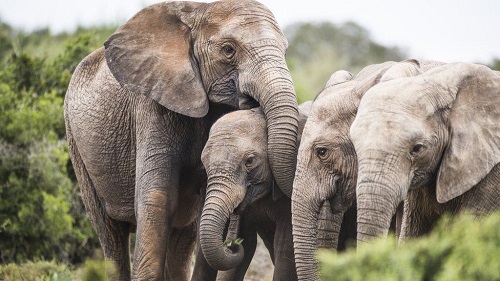
BY DARGIE KAHSAY
The Babile Elephant Sanctuary, which is Located 560 KM East of Addis Ababa and 30 km south of Harar city, was established 51 years ago to protect Elephants in Eastern part of Ethiopia. The Babile Elephant Sanctuary, found within Oromia and Somali regional states covers an area of 6,892 hectare of land, is among the known Elephant sanctuaries in Ethiopia and the only home of Elephants in Eastern Ethiopia.
During the early establishment of the sanctuary, over 600 Elephants were found within Babile Elephant Sanctuary, according to head of the Sanctuary administration. But now, the number of elephants has decreased by half and remains around 300 elephants with frequent decrease in number, Sanctuary Administrator Adem Mohammed told The Ethiopian Herald.
According to Adem, Babile Elephant Sanctuary is home to over 31 mammal species, 225 bird species and over 330 different plant species. The sanctuary is among the biggest and oldest sanctuaries with rich wildlife resource in Ethiopia. It is the blessing natural gift of the Eastern part of Ethiopia which helps the area to protect biodiversity and ecology in the lowland area and becomes the habitat of different animal species.
Babile Elephant Sanctuary founds within three zonal administrations and 10 woredas within both Oromia and Somali regional states. In addition to the well-known wildlife of the sanctuary, Elephant, the sanctuary hosts black mane-lion, two different species of monkey, cheetah and other mammal species.
Found between the two Eastern cities of Ethiopia, Harar and Jigjiga, the sanctuary is a suitable place to attract local and foreign visitors, Adem stated. Babile Elephant Sanctuary mainly encompasses lowlands of Erer, Daketa, Fafen, Gobele and Borale which all are sources of tributaries for Shebelle River. In addition, it also encompasses a plateau landscape.
According to the Sanctuary’s administration head, previously the Elephants were habituated within all the five different zones of the sanctuary, but now, due to illegal expansion by the people to the sanctuary, the available elephants appear in limited numbers only within the two zones of the park.
Adem, sanctuary head, said that 11 elephants were killed only during the past eight months. During the past six years, 49 elephants were killed within the sanctuary. Almost daily, there is conflict between elephants and people of the area. There is no safe place for the elephants due to the rapid encroachment of the local people in the reserved areas for agricultural and residential purposes, Adem stated.
“In six years only 28 people were affected by elephants, of which 20 died and 8 got seriously injured. In addition, 48 elephants were killed and many injured. Not only that, during the past eight months only 11 elephants were killed illegally and elephants killed six people and injured two,” Adem stated adding that “this is due to the reason that the habitat and home of the elephants are invaded by people illegally.” Hence, he said, the elephants are in conflict with the people in their day-to-day activities.
“Even three days ago, a child was beaten by elephant in the sanctuary,” Adem added. Expansion of illegal grazing, agricultural expansion and illegal settlement of human beings is seriously endangering the sanctuary’s destiny and the wildlife species within the sanctuary, including the elephant, he reiterated. Due to continued illegal settlement, unmanageable and controlled overgrazing, deforestation for charcoal and agricultural expansion, the wildlife within the sanctuary are facing shortage of water and food.
According to Adem, since the protected areas of the sanctuary are becoming affecting by these illegal activities, the elephants are forced to withdraw from the sanctuary in search of food and water. In addition, due to lack of enough food, the elephants went to the agricultural fields of the farmers of the area, hence, he said, during this time people-to-elephant conflict happens.
For Adem in addition to continued illegal expansion of human settlement, agriculture and lack of water and food, the elephants are also becoming targets for their teeth since the sanctuary founds in a safe place for exit to abroad in two directions, to Somaliland and Djibouti. With all these challenges, Babile Elephants are facing serious survival challenges and their population is shockingly decreasing from time to time, he stated. “Losing 11 elephants within eight months means a lot and it needs urgent intervention to control it timely,” he underlined.
For Adem, not only the Babile elephants, the population of elephant in Ethiopia are decreasing due to different reasons, mainly illegal settlement of population, agricultural expansion and overgrazing. According to him, the major causes for the declining of elephant population are due to manmade problems including destroying the habitats of wildlife and other activities.
“With the current trend of illegal settlement and unmanageable activities within Babile sanctuary,” Adem stressed “it is difficult to see elephant within the sanctuaries after few years.” Though the problem is high with Babile sanctuary, it is not the only sanctuary that faced manmade hazards, illegal expansion of settlement and agriculture remains common problem for almost all sanctuaries and national parks.
“Since elephants are poached for their ivory, losing of their habitation for human beings affected the existence of this big animal in Ethiopia,” he underlined. For immediate solution to save the sanctuary and the wildlife within the sanctuary, Adem calls local, regional and federal authorities to give due attention in controlling further settlement of people and relocating the already illegally settled within and surroundings of the sanctuary since it is beyond the park’s capacity.
Medium and long term solutions are also needed to restore the sanctuary’s holding and forest through researches and additional greenery investments. Haramaya University already started efforts to support the sanctuary with researches to provide research based solutions, he added.
Nationally, to solve the challenges that Ethiopian parks are facing, it is important to develop the capacity of workers and administrations of parks, awareness creation at grassroots level, infrastructural investments and applying other mechanisms to benefit communities around the parks are necessary steps. In addition, developing the number and capacity of wildlife and park rangers, implementing strong policies, allocating adequate budget to national parks and controlling illegal settlements and agricultural expansions to protected forest areas and other dense forests is must, according to Adem.
“There was Rhinoceros in Ethiopia, but they have vanished only during the past three decades” Adem said adding “with the current trend the destiny of elephants would be the same unless actions are taken on time”
On its Saturday edition, Addis Maleda newspaper reported that due to the conflict in Northern Ethiopia, 300 elephants have migrated to Eritrea from Kafta Sheraro National Park, citing head of the park administration. This indicated that due to different reasons, the elephant population is facing serious challenges and needs urgent action to safe the specie and increase the population.
Meanwhile, during his recent interview with The Ethiopian Herald, Wildlife Protected Areas Director at Ethiopian Wildlife Protection Authority, Desta Bedaso stated that only in six months of this budget year 18 elephants were killed in Ethiopia in different parts of the country. Nationally, the population of elephant is showing decrements and the authority names this year “elephant year” to give due attention for elephant.
Desta shares Adem’s idea that illegal settlement and agricultural expansion to protected areas and parks remains the main head ache for wildlife protection.
A press statement prepared in connection with this year’s world wildlife day, Ethiopian Wildlife Protection Authority (EWPA) underlined that Ethiopia celebrates the day by investing in awareness on elephant specie that listed among endangered wildlife. EWPA on its statement underlined “elephant, which is named as engineer of ecosystem, is among the endangered wild animals in Ethiopia.”
According to EWPA’s statement, the population of elephant in Ethiopia currently is less than 2000 and lived within nine protected areas.
The Ethiopian Herald March 29/2022




